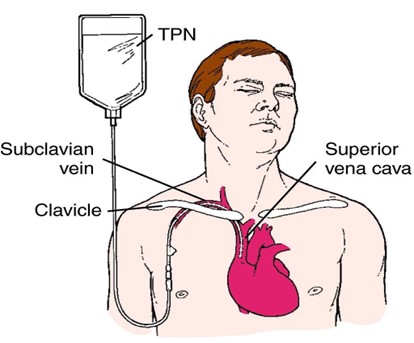A nurse is planning care for a client who has a new prescription to receive a continuous infusion of total parenteral nutrition (TPN) Which of the following interventions should the nurse implement?
Change the TPN infusion tubing once every 3 days
Check the client's blood glucose level regularly
Insert the peripheral IV catheter for administration
Monitor the client's weight every 3 days
The Correct Answer is B
When caring for a client receiving a continuous infusion of total parenteral nutrition (TPN), the nurse should implement the intervention of checking the client's blood glucose level regularly. TPN is a highly concentrated intravenous nutrition solution containing glucose, amino acids, lipids, vitamins, and minerals, and it is used to provide complete nutrition when the client cannot take oral nutrition.
Monitoring blood glucose levels regularly is essential because TPN is rich in glucose, which can significantly affect the client's blood sugar levels. Hyperglycemia (high blood sugar) is a potential complication of TPN infusion. Regular blood glucose monitoring allows the nurse to detect and address any changes in blood sugar levels promptly and to adjust the TPN infusion rate or administer insulin, if necessary, to maintain the client's blood sugar within the target range.
Let's go through the other options:
A. Change the TPN infusion tubing once every 3 days: While changing the TPN infusion tubing regularly is a good practice to maintain asepsis and prevent infection, it is not the priority intervention in this situation. Regularly checking the client's blood glucose level is more crucial to monitor the effects of TPN on blood sugar levels.
C. Insert the peripheral IV catheter for administration: Total parenteral nutrition is a hypertonic solution that can cause irritation and damage to peripheral veins. It is usually administered through a central venous catheter (CVC) placed in a large vein, such as the subclavian or jugular vein. Inserting a peripheral IV catheter for TPN administration is not recommended due to the risk of vein damage and thrombosis.
D. Monitor the client's weight every 3 days: Monitoring the client's weight is an important part of assessing their nutritional status and fluid balance. However, the priority intervention for a client receiving TPN is checking their blood glucose level regularly, as hyperglycemia is a common and significant concern in TPN administration.

Nursing Test Bank
Naxlex Comprehensive Predictor Exams
Related Questions
Correct Answer is B
Explanation
A. History of asthma:Verapamil is a calcium channel blocker and does not affect the airways or cause bronchospasm, unlike beta-blockers, which can exacerbate asthma.
B. History of heart failure:Verapamil has negative inotropic effects, meaning it decreases the strength of heart contractions. This can exacerbate heart failure, particularly in clients with reduced ejection fraction (systolic heart failure). It is generally contraindicated in clients with severe heart failure as it can worsen symptoms.
C. Systolic BP 110 mm Hg:While verapamil can cause a drop in blood pressure due to its vasodilatory effects, a systolic blood pressure of 110 mm Hg is not an absolute contraindication.
D. A blood creatinine level of 1.0 mg/dL is within the normal range (approximately 0.6–1.2 mg/dL for adults). Verapamil is not contraindicated in clients with normal renal function.
Correct Answer is ["A","C","D","E"]
Explanation
The nurse should plan to take the following actions:
A.Verify the prescription: Before administering any medication, the nurse must verify the prescription to ensure accuracy, appropriateness, and that it matches the provider's order.
Regarding option B, administering the medication at 1000, 1400, 1800, and 2200 may not be appropriate. The prescription states that ampicillin should be administered every 6 hours. The nurse should administer the medication at equally spaced intervals throughout the day. If the medication is prescribed every 6 hours, the appropriate administration times would be 0600, 1200, 1800, and 2400. However, the question does not provide sufficient information to determine the exact administration times, so option B cannot be definitively selected.
C. Assess the client for an allergy to penicillin: Since ampicillin is a penicillin-class antibiotic, it is essential for the nurse to assess the client for any history of allergies to penicillin or other beta-lactam antibiotics. A penicillin allergy could lead to a severe allergic reaction, so it is crucial to identify any potential allergies before administering the medication.
D. Document giving the medications: After administering the ampicillin, the nurse should document the administration in the client's medical record, including the time, dose, route, and any relevant observations or assessments.
E. Obtain a sputum for culture and sensitivity: The client's new prescription for ampicillin may be related to an infection. To ensure appropriate and effective treatment, obtaining a sputum specimen for culture and sensitivity is necessary. This will help identify the specific bacteria causing the respiratory infection and determine which antibiotics will be most effective in treating it.
Whether you are a student looking to ace your exams or a practicing nurse seeking to enhance your expertise , our nursing education contents will empower you with the confidence and competence to make a difference in the lives of patients and become a respected leader in the healthcare field.
Visit Naxlex, invest in your future and unlock endless possibilities with our unparalleled nursing education contents today
Report Wrong Answer on the Current Question
Do you disagree with the answer? If yes, what is your expected answer? Explain.
Kindly be descriptive with the issue you are facing.
